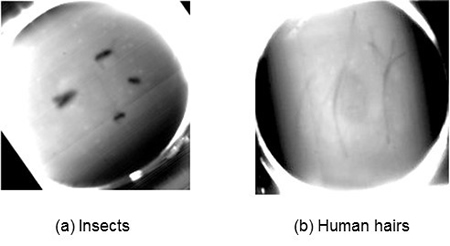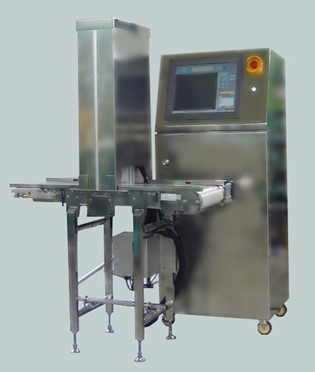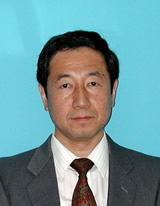
ここからコンテンツです。

Near-infrared (NIR) optical imaging system for detecting small organic objects in thick foods
By Mitsuo Fukuda
Mitsuo Fukuda and his colleagues, in cooperation with Aichi Science & Technology Foundation, have developed basic real-time imaging techniques for detecting small organic objects in foods, based on a simple technique of monitoring the distribution of the infrared light transmitted through the materials. The newly developed system has proven itself in being able to detect objects such as a human hair, a piece of plastic and a piece of rubber encased in 5-mm-thick chocolate, none of which can be picked up using an X-ray detection sensor and a metal detector.

To be able to detect foreign objects in foods on factory production lines is important for our health and safety and is normally performed using an X-ray computed tomography apparatus or a metal detector. Dense materials such as a piece of stone or metal can be easily detected, and foods containing them are removed from the production lines.
However, foreign organic objects in foods cannot be detected with this equipment, and so the need for new techniques to detect them has been around for some time.
Now, Mitsuo Fukuda and his colleagues in TUT and Aichi Science & Technology Foundation, have developed novel real-time NIR optical imaging systems comprising a two-dimensional (2D) optical source composed of 850-nm-wavelength-band LEDs, a CMOS sensor, and optimized optical systems. The optical system accurately detected organic objects such as a human hair, part of an insect, plastic, and a piece of rubber in a piece of 5-mm-thick chocolate in real time. Additionally, the bone structures in chicken wings of about 20-mm in thickness were also able to be detected.
"We have developed some basic techniques required for constructing a real-time optical imaging system with high spatial resolution. The developed system has a simple optical structure and is tolerant of mechanical vibration. This optical imaging system is, therefore, applicable to mass-production lines of foods in factories, where real-time monitoring is required with high spatial resolution.”

The author Prof. Mitsuo Fukuda said "We only developed some basic techniques and systems for a real-time optical imaging system for detecting foreign organic objects and will need to customize them for application to each type of food in the future”.
The developed real-time NIR imaging system will be applicable for the observation of internal images of moving samples such as foods in mass-production lines in factories with high spatial resolution. Consequently, this system will promote food safety and security in our daily lives.
Patents
- 特願2014-102334 「透過検査装置」
- 特願2012-185373 「食品検査装置」
Reference
Souphaphone Phetchalern, Hiroto Tashima, Yuya Ishii, Takeshi Ishiyama, Shinichi Arai, Mitsuo Fukuda (2014). Near-infrared imaging equipment thatdetects small organic substances in thick foods, Proceeding of SPIE 9192, 91921A-1-91921A-6, 2014. 10.1117/12.2061455
Hiroto Tashima, Tsuneaki Genta, Yuya Ishii, Takeshi Ishiyama, Shinichi Arai, Mitsuo Fukuda (2013). Near-infrared imaging system for detecting small organic foreign substances in foods, Proceeding of SPIE 8841, 884117-1-884117-7. 10.1117/12.2023541
Tsuneaki Genta, Hiroto Tashima, R. Shimokita, Shinichi Arai, and Mitsuo Fukuda (2012). Development of a real-time optical imaging system for monitoring food quality and assessing human body parts using diffused light, Proceeding of SPIE 8550, 85500F-1 - 85500F-8. 10.1117/12.980257
近赤外(NIR)光を利用した食品中の有機異物検査システム
電気・電子情報工学系、福田光男教授の研究グループは、愛知県の科学技術交流財団と協同で食品中の有機異物の検査システムを開発しました。NIR光を食品に照射し、食品を透過するNIR光の透過像を観察するものです。開発された新たなシステムにより、厚さ5ミリメートルのチョコレートに埋め込まれた、エックス線検査装置や、金属探知機では検出できない昆虫や毛髪を、実時間検出することが可能となりました。
食品工場の製造ライン等においてエックス線検査装置や金属探知機による食品中の異物検査は食の安全・安心に欠くことのできないものです。これらの検査では金属片や小石等の密度の高い異物を検出することが可能です。
しかしながら、昆虫や毛髪などの有機異物については、検出することが極めて困難でした。
福田光男教授の研究グループと愛知県の科学技術交流財団は、これらの問題に対し、850ナノメートの光を放出するLEDを2次元アレイ状に並べた平面光源とCMOSカメラおよび適切な光学系からなる新たな実時間NIR光イメージング観察装置を開発しました。開発したシステムにより、5ミリメートルの厚さのチョコレートへ埋め込まれた昆虫や毛髪、さらには厚さ20ミリメートルの手羽元や手羽先中の骨格等の実時間観察が可能となりました。
開発されたNIR光を用いた食品の透過像の実時間観察技術は高い空間分解能を有しており、非常に単純な構造のため、機械的な振動への耐性が高いという特徴があります。そのため、食品工場の大量生産ラインへの適用が可能です。
著者の福田は、「我々は食品中の有機異物検出のためのNIR光透過像の実時間観察技術の基礎を開発しましたが、今後いろいろな食品対応でそれらの技術/装置を最適化していく必要がある。」と話しています。
今回開発された装置は比較的高速で動いている食品の内部観察を高分解能で行えるために、食品工場での大量生産ライン等で、有機異物の検出に用いることのできる可能性があります。そのため、我々の日常生活の食の安全・安心への寄与が期待されます。
Researcher Profile

| Name | Mitsuo Fukuda |
|---|---|
| Affiliation | Department of Electrical and Electronic Information Engineering |
| Title | Professor |
| Fields of Research | Photonics / Optoelectronics |
ここでコンテンツ終わりです。
